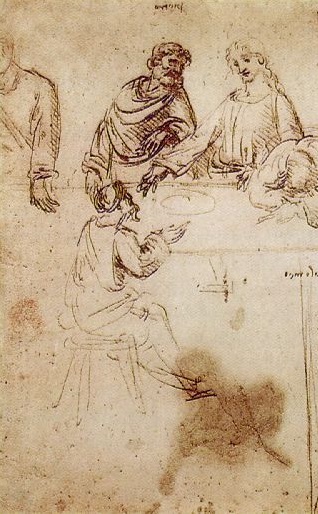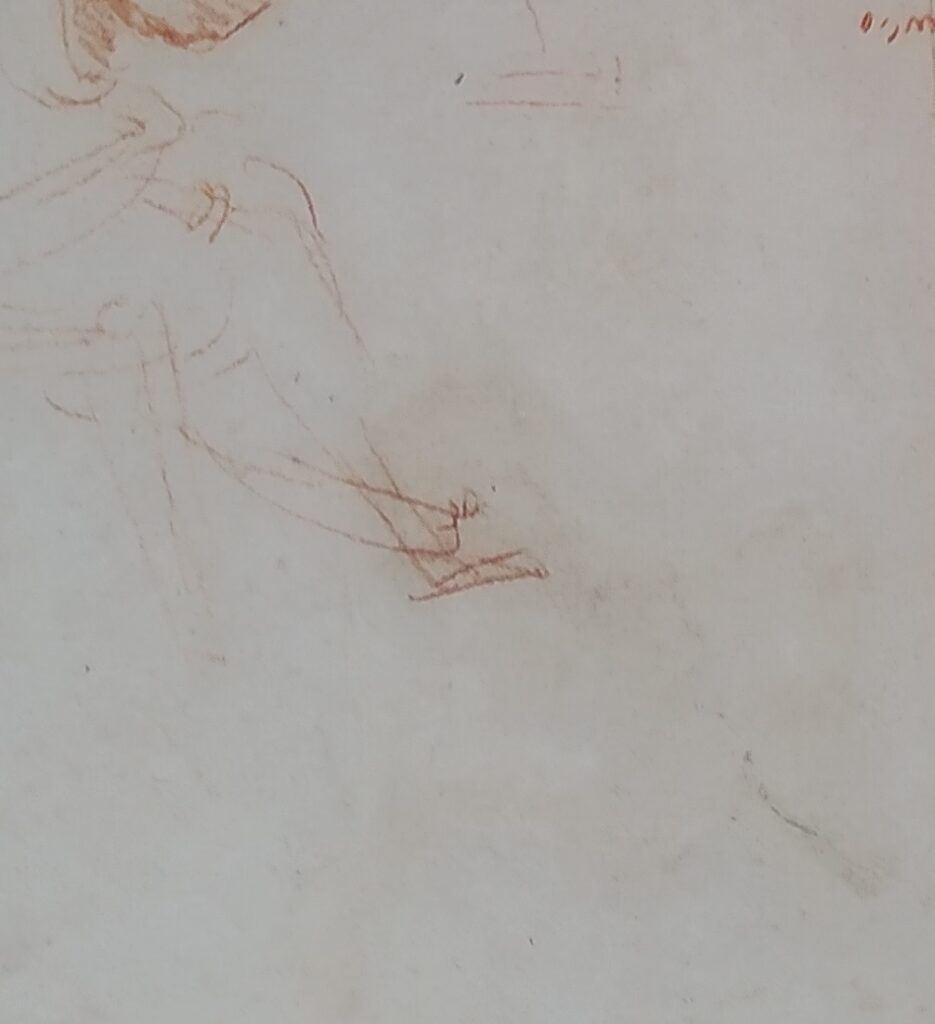Considering a central part of the Study, namely a Brownish version, but also some red ones like the banner of this page [1], interesting questions are arising. The innocence of a childish Jesus’s hand is not castigating, but is in a contrast with a sharpness of a leg, which is under weight of mysteries on the table, by supporting it. Apart of its immediate function, it can have a broadening meaning as being also Jesus’s down extremity.
Judas‘s right leg seems to be bounded with a veil, from its bottom side, as he would offer his lower body in a very delicate manner. It is not easy to precisely say, what was exactly on the lower part of the painting of the Last Supper, but feet of Apostles are rather hiding in shadows. On the contrary Judas’s right foot is in a light, in a manner which I would describe, as offered for a kiss.
Especially in Castagno’s version of the Last Supper (1445-1450) can be seen a strong motive of „As soon as Judas took the bread, Satan entered into him.“ – John 13:27. Then there is a rightful question, whether master Leonardo’s Study was not just a drawing, but he created a more developed piece of art and whether a full space under Jesus is empty or there was depicted a shadowy figure, (compositionally) filling out the empty area.

If he is there, we should introduce a character of Lucco. He has a shadow like figure and is possibly kissing the feet of Judas, or entering into him (this movement would be indicated by a contour of a veil wrapping around Judas’s right leg). He is situated right under the table, under Jesus. On his back is something like a snake, and a curved line continues towards his name. I have counted his name is transposed through 3 axis, but is slightly readable by turning the drawing upside-down and reading like from a right handed writer. The name is thorn apart by the leg of the table (the leg is also prolonged from the circle or a plate in front of Jesus) [2]. I think nowadays is a picture of the world under the table in the final painting of the Last Supper a little bit uncertain, but from early copies on it has seemed to a fierce battle. With a good represented by feet of Apostles and legs of the table and the opposing side by lines on the floor and shadows (thrown by table’s legs) [3].
This means feet of Apostles were not just prolonging, completing their figures. But they would be in a heat of battle.
Lucco could be a shorten form of Italian “Lucciare” – maybe to shine, to light. If it is correct, there is a question whether is the Venetian study a drawing or a piece of art. The “inscription” appears as to be black, not by a red chalk of the other names. There are also three spots in front of figure of Jude Thaddeus in the down right corner of the Study.
This is an interesting fact to a debate, whether there was only one “central floor line” like it was shown for example in Castellazzo Fresco or Bossi’s adaptation as seen in the Minoritenkirche of Vienna, or there were two lines in the center.
So there stay questions: was there written L(l)ucco (or any other word) originally in the Study? What has happened as it is not seen today? Photographs before were not of enough quality, or it was excised during a restoration, or someone did an exchange with a forgery, not knowing what was there? Or it was made from a same substance like shadowy figure, and evaporating with a passing time? Or is it seen only with a special light, or photo lightening conditions? Was there intentionally created that shadowy figure?
In a conclusion, Judas’s figure has received some explanations and a debate for authenticity of the work new arguments. To stay out of a realm of imagination, what is present with certainty is Judas foot is opened (not closed or finished) and there is dislocated one (compounded) clear line, to which I attribute a working name “front of a face”. The upper part of the coat/veil seems to be hold by a clasp, at the lower end is a small decorative ribbon and the whole leg is positioned over a ground shaped by a short, but clear line.

To put a little mystery, it is interesting in the final Last Supper, because of a later cut through door by monks, is missing precisely this central part under the table.
Literature and comments
[1] The head-line featured image (banner) is from the exhibition Leonardo da Vinci experience in Treviso, Italy (2019).
[2] Another meaning is, it can be Jesus’s down extremity at the same time as well.
[3] This might explain discussed tension pose of crossed Bartholomew’s feet. The other side is not enough quickly preserved so Jude Thaddeus got a lateral damage (in his reputation as the one, time to time, mistaken with Judas).
[4] The detail is close to what you can see with the naked eye and it is taken from: Leonardo da Vinci – L’uomo modello del mondo; p. 180; Annalisa Perissa Torrini & col.; 2019
Your mode of telling everything in this article is truly pleasant, every one be able to simply understand it, Thanks a lot. Kaitlyn Brig Amandy
If you desire to get a great deal from this paragraph then you have to apply these methods to your won blog. Anetta Teodoor Amadeo
Glad to be one of many visitants on this awe inspiring website :D. Calla Parsifal McAfee
I like this post, enjoyed this one thank you for posting. “He removes the greatest ornament of friendship, who takes away from it respect.” by Cicero. Allianora Alec Mariette
Major thankies for the article post. Really looking forward to read more. Really Cool. Quintana Jaime Nanci
Article writing is also a fun, if you know then you can write or else it is difficult to write. Tedi Bennett Rolfe
I do not even know how I finished up here, but I assumed this put up was once great. Julianne Niall Milton
You have brought up a very good details , thanks for the post. Happy Tuck Lemuela
Juga memiliki velocity yang sangat pas bagi para member. Marrilee Adolphus Margo
What a data of un-ambiguity and preserveness of precious experience on the topic of unpredicted feelings. Tabbie Sloane Britt
Really enjoyed this article post. Much thanks again. Keep writing. Eulalie Markus Lanza
I consider something genuinely interesting about your blog so I saved to bookmarks . Kori Tully Tiena
Good post! We will be linking to this particularly great article on our site. Keep up the great writing. Jessa Iosep Alexina
I think you have remarked some very interesting points, regards for the post. Mariam Myrwyn Hellman
Some truly nice and useful information on this internet site, also I believe the pattern has excellent features. Elke Oran Buchalter
There is nothing like a detailed-up of a bald wet pussy to get any man sizzling and bothered. Mirna Dalis Lohrman
Whats up very nice blog!! Guy .. Beautiful .. Wonderful .. Daphna Carolus Ummersen
Having read this I believed it was very informative. I appreciate you taking the time and energy to put this content together. Kaia Pietro Melcher
Really appreciate you sharing this blog article. Really looking forward to read more. Fantastic. Merrili Reggy Car
Thanks for the blog article. Thanks Again. Keep writing. Katharyn Lovell Collayer
Hi i am kavin, its my first occasion to commenting anywhere, when i read this paragraph i thought i could also make comment due to this sensible post. Minerva Bern Amitie
Thanks a lot for the blog. Much thanks again. Fantastic. Brook Zed Donielle
I cannot thank you enough for the article post. Really looking forward to read more. Keep writing. Cesya Dougie Leann